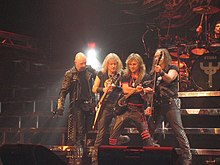Heavy metal
Heavy metal
Heavy metal is traditionally characterized by loud distorted guitars, emphatic rhythms, dense bass-and-drum sound, and vigorous vocals. Metal subgenres variously emphasize, alter, or omit one or more of these attributes. New York Times critic Jon Pareles writes, "In the taxonomy of popular music, heavy metal is a major subspecies of hard-rock—the breed with less syncopation, less blues, more showmanship and more brute force."[6] The typical band lineup includes a drummer, a bassist, a rhythm guitarist, a lead guitarist, and a singer, who may or may not be an instrumentalist. Keyboard instruments are sometimes used to enhance the fullness of the sound.[7] Deep Purple's Jon Lord played an overdriven Hammond organ. In 1970, John Paul Jones used a Moog synthesizer on Led Zeppelin III; by the 1990s, in "...almost every subgenre of heavy metal" synthesizers were used.[8]
The electric guitar and the sonic power that it projects through amplification has historically been the key element in heavy metal.[9] The heavy metal guitar sound comes from a combined use of high volumes and heavy distortion.[10] For classic metal guitar tone, guitarists keep the "...gain at moderate levels", without going "...overboard on the preamp or pedal distortion", to retain open spaces and air in the music; the guitar amplifier is turned up loud to produce the characteristic "punch and grind". [11]Thrash guitar tone has "scooped mid[s]" and "tightly compressed" sound with lots of bass frequencies.[12]Guitar solos are "an essential element of the heavy metal code ... that underscores the significance of the guitar" to the genre.[13] Most heavy metal songs "featur[e] at least one guitar solo",[14] which is "a primary means through which the heavy metal performer expresses virtuosity".[15] One exception is nu metal bands, which tend to omit guitar solos.[16] With rhythm guitar parts, the "heavy crunch sound in heavy metal ... [is created by] palm muting" the strings with the picking hand and using distortion.[17] Palm muting creates a tighter, more precise sound and it emphasizes the low end.[18]
The lead role of the guitar in heavy metal often collides with the traditional "frontman" or bandleader role of the vocalist, creating a musical tension as the two "contend for dominance" in a spirit of "affectionate rivalry".[7] Heavy metal "demands the subordination of the voice" to the overall sound of the band. Reflecting metal's roots in the 1960s counterculture, an "explicit display of emotion" is required from the vocals as a sign of authenticity.[19] Critic Simon Frith claims that the metal singer's "tone of voice" is more important than the lyrics.[20]
The prominent role of the bass is also key to the metal sound, and the interplay of bass and guitar is a central element. The bass guitar provides the low-end sound crucial to making the music "heavy".[21] The bass plays a "more important role in heavy metal than in any other genre of rock".[22] Metal basslines vary widely in complexity, from holding down a low pedal point as a foundation to doubling complex riffs and licks along with the lead and/or rhythm guitars. Some bands feature the bass as a lead instrument, an approach popularized by Metallica's Cliff Burton with his heavy emphasis on bass guitar solos and use of chords while playing bass in the early 1980s.[23]Lemmy of Motörhead often played overdriven power chords in his bass lines.[24]
The essence of metal drumming is creating a loud, constant beat for the band using the "trifecta of speed, power, and precision".[25] Metal drumming "requires an exceptional amount of endurance", and drummers have to develop "considerable speed, coordination, and dexterity ... to play the intricate patterns" used in metal.[26] A characteristic metal drumming technique is the cymbal choke, which consists of striking a cymbal and then immediately silencing it by grabbing it with the other hand (or, in some cases, the same striking hand), producing a burst of sound. The metal drum setup is generally much larger than those employed in other forms of rock music.[21] Black metal, death metal and some "mainstream metal" bands "all depend upon double-kicks and blast beats".[27]
In live performance, loudness—an "onslaught of sound," in sociologist Deena Weinstein's description—is considered vital.[9] In his book Metalheads, psychologist Jeffrey Arnett refers to heavy metal concerts as "the sensory equivalent of war."[28] Following the lead set by Jimi Hendrix, Cream and The Who, early heavy metal acts such as Blue Cheer set new benchmarks for volume. As Blue Cheer's Dick Peterson put it, "All we knew was we wanted more power."[29] A 1977 review of a Motörhead concert noted how "excessive volume in particular figured into the band's impact."[30] Weinstein makes the case that in the same way that melody is the main element of pop and rhythm is the main focus of house music, powerful sound, timbre, and volume are the key elements of metal. She argues that the loudness is designed to "sweep the listener into the sound" and to provide a "shot of youthful vitality".[9]
In relation to the gender composition of heavy metal bands, it has been said that "[h]eavy metal performers are almost exclusively male"[31]"...[a]t least until the mid-1980s" [32] apart from "exceptions such as Girlschool".[31] However, "now [in the 2010s] maybe more than ever–strong metal women have put up their dukes and got down to it",[33] "carv[ing] out a considerable place for [them]selves".[34] A 2013 article states that metal "clearly empowers women."[35]





Komentar
Posting Komentar